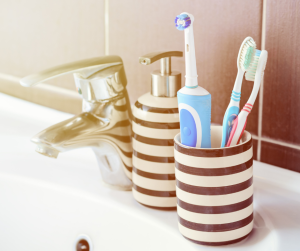Is It Better for My Oral Health to Use an Electric or Manual Toothbrush?
Posted by Nicole
We get asked this question a lot when it comes to electric vs. manual toothbrushes. Rightfully so, considering there is a significant price difference between the two. You can purchase a regular manual toothbrush for as little as a dollar, while some higher-end rechargeable electric toothbrushes that can sync to an app on your phone can cost more than $250 plus the cost of replacement brush heads.
We’ll briefly discuss some of the advantages of each as well as some potential disadvantages. Bear in mind, whichever you choose, dentists agree that brushing your teeth properly for 2 minutes, twice a day is the most effective step you can take for oral health.
Some of the biggest issues we see with brushing are time and technique.
Most people tend to only brush for about 45 seconds. Many electric toothbrushes offer built-in timers in which the toothbrush stops when you have reached the 2-minute mark. Additionally, people tend to brush more in some areas of their mouths than others. Some electric models have a quadrant timer that buzzes every 30 seconds to remind you to move to another area of your mouth. Timing and moving about the mouth can easily be accomplished with a manual toothbrush, you just need to pay attention.
Electric toothbrushes certainly have more power, but too much power can also be problematic. Brushing hard can lead to gum recession and damaged tooth enamel. However, this damage could also occur when using a manual toothbrush.
Whether using an electric or a manual toothbrush, to get the most out of each brushing session, it is important to:
- Hold the toothbrush at the proper angle. People tend to hold their toothbrush at a 90-degree angle which cleans the teeth, but not the gums. Bacteria can grow in the space between the teeth and gums, so it is important to hold the brush at a 45-degree angle so that the bristles can reach below the gumline.
- Be thorough. Clean every surface of every tooth.
- Don’t brush too hard. Signs of brushing too hard are bleeding or irritated gums, and tooth sensitivity. Also, look at your bristles – are they “splaying” or wearing out very quickly? If so, take it easier.
- Replace your toothbrush or toothbrush heads regularly.
Some electric toothbrushes (the ones that sync with apps) can provide you with “pointers” on how to improve your technique which some people may find helpful. But it isn’t hard to accomplish the proper technique with a manual toothbrush. We’ve been helping people do this for years.
The bottom line: It’s a personal preference. If you are going through your regular dental checkups with flying colors and you are confident you are doing a thorough job, whichever type of toothbrush you use is just fine.
Wondering if you are doing a good job or would like to discuss this further? Be sure to talk with your hygienist or one of our dentists at your next appointment. Is it time to get on the schedule? Request your next appointment here. We’re ready to see you and to help you feel confident in caring for your smile at home.
